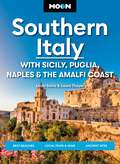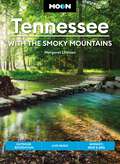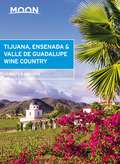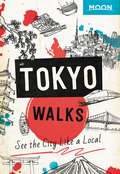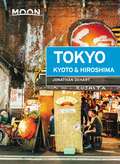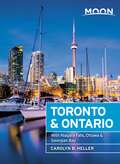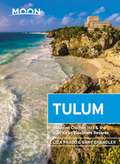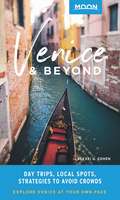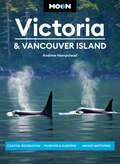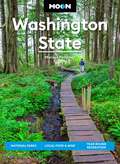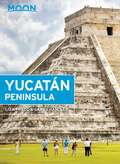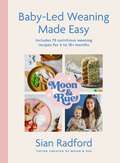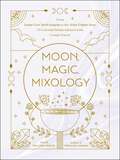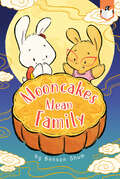- Table View
- List View
Moon Southern Italy: Best Beaches, Local Food & Wine, Ancient Sites (Moon Europe Travel Guide)
by Laura Thayer Moon Travel Guides Linda SarrisFrom the pastel rooftops of Positano to the soaring peak of Mount Etna, immerse yourself in la dolce vita with Moon Southern Italy. Inside you'll find:Flexible itineraries for exploring the best of Southern Italy, including Naples, Pompeii, Sicily, Puglia, the Amalfi Coast, and more, that can be combined for a longer trip Must-see highlights and unique experiences for any season: Dive into the art museums and traditional theater of Palermo&’s Centro Storico and admire the Baroque monuments and carved churches of Lecce. Walk the frozen-in-time streets of Pompeii and marvel at the captivating Cathedral of Amalfi. Take an off-road Jeep tour of Mount Etna or hike along the coastline. Soak up the sun on a secluded beach or sail the crystal-clear Mediterranean waters The best local flavors: Stroll quiet village streets where the scent of Sunday ragu fills the air, feast on fresh seafood from a bustling outdoor market, and chow down on authentic Neapolitan pizza. Sip limoncello on a sunny terrace or sample wines from the mineral-rich local vineyards Expert suggestions from local authors Laura Thayer and Linda Sarris on where to stay, what to eat, and how to get around Full-color photos and detailed maps throughoutBackground information on the landscape, history, and cultural customs, plus an Italian phrasebook With Moon&’s practical tips and local insight on the best things to do and see, you can experience the very best of Southern Italy. Exploring more of Italy? Check out Moon Rome, Florence & Venice.About Moon Travel Guides: Moon was founded in 1973 to empower independent, active, and conscious travel. We prioritize local businesses, outdoor recreation, and traveling strategically and sustainably. Moon Travel Guides are written by local, expert authors with great stories to tell—and they can't wait to share their favorite places with you. For more inspiration, follow @moonguides on social media.
Moon Southern Italy: Sicily, Puglia, Naples & the Amalfi Coast (Travel Guide)
by Laura Thayer Linda SarrisFrom the pastel rooftops of Positano to the soaring peak of Mount Etna, immerse yourself in la dolce vita with Moon Southern Italy. Inside you'll find:Flexible itineraries for exploring the best of Southern Italy, including Sicily, Puglia, Naples, the Amalfi Coast, and more, that can be combined for a longer trip Strategic advice for foodies and oenophiles, art lovers, hikers, history buffs, beach bums, and more Must-see highlights and unique experiences for any season: Dive into the art museums and traditional theater of Palermo&’s Centro Storico, and admire the Baroque monuments and carved churches of Lecce. Walk the frozen-in-time streets of Pompeii and marvel at the captivating Cathedral of Amalfi. Take an off-road Jeep tour of Mount Etna or hike along the coastline. Soak up the sun on a secluded beach or sail the crystal-clear Mediterranean waters The best local flavors: Stroll quiet village streets where the scent of Sunday ragu fills the air, feast on fresh seafood from a bustling outdoor market, and chow down on authentic Neapolitan pizza. Sip limoncello on a sunny terrace or sample wines from the mineral-rich local vineyards Expert suggestions from Amalfi local Laura Thayer and Palermo local Linda Sarris on where to stay, where to eat, and how to get around Full-color photos and detailed maps throughoutHelpful resources on COVID-19 and traveling to Southern Italy Background information on the landscape, history, and cultural customs Handy tools including an Italian phrasebook and tips for seniors and traveling with children With Moon&’s practical tips and local insight on the best things to do and see, you can experience the very best of Southern Italy. Exploring more of Italia? Check out Moon Milan & Beyond with the Italian Lakes or Moon Rome, Florence & Venice. About Moon Travel Guides: Moon was founded in 1973 to empower independent, active, and conscious travel. We prioritize local businesses, outdoor recreation, and traveling strategically and sustainably. Moon Travel Guides are written by local, expert authors with great stories to tell—and they can't wait to share their favorite places with you. For more inspiration, follow @moonguides on social media.
Moon Tennessee (Travel Guide)
by Margaret LittmanThe birthplace of the blues, the cradle of country music, and the home of the Smokies: get to know the Volunteer State with Moon Tennessee. Inside you'll find:Strategic, flexible itineraries, from a long weekend in Nashville to a Great Smokies road trip, designed for history buffs, families, outdoor adventurers, music lovers, and more, including day trips from Memphis and NashvilleThe best local flavors: Dig in to fiery hot chicken and authentic Southern barbecue or sip on samples at the Jack Daniels DistilleryCan't-miss music: Catch a performance on the Grand Ole Opry stage or follow in the footsteps of the King at Graceland. Two-step with the locals at a beloved honkytonk, listen to the strums of bluegrass, or tour studios where legends like Johnny Cash recorded their hitsOutdoor adventures: Go whitewater rafting in Cherokee National Forest, hike to rushing waterfalls in Great Smoky Mountains National Park, or spot wild bison in the Land Between the Lakes Expert advice from local Nashvillian Margaret Littman on when to go, where to eat, and where to stay, from rugged campgrounds to historic inns Full-color photos and detailed maps throughout Accurate, up-to-date information on the landscape, wildlife, and history of TennesseeTrusted recommendations for LGBTQ+ travelers, international visitors, seniors, and travelers with disabilitiesWith Moon Tennessee's practical tips and local know-how, you can experience the best of the state.Hitting the road? Check out Moon Nashville to New Orleans Road Trip.
Moon Tennessee: Outdoor Recreation, Live Music, Whiskey, Beer & BBQ (Travel Guide)
by Margaret LittmanThe birthplace of the blues, the cradle of country music, and the home of the Smokies: get to know the Volunteer State with Moon Tennessee. Inside you'll find:Strategic, flexible itineraries, from a long weekend in Nashville to a Great Smokies road trip, plus day trips from Memphis and NashvilleThe best local flavors: Dig in to fiery hot chicken and authentic Southern barbecue or sip on samples at the Jack Daniels Distillery Can't-miss music: Catch a performance on the Grand Ole Opry stage or follow in the footsteps of the King at Graceland. Two-step with the locals at a beloved honky-tonk, listen to the strums of bluegrass, or tour studios where legends like Johnny Cash recorded their hits Outdoor adventures: Go whitewater rafting in Cherokee National Forest, hike to rushing waterfalls in Great Smoky Mountains National Park, or spot wild bison in the Land Between the Lakes Expert advice from local Nashvillian Margaret Littman on when to go, where to eat, and where to stay, from secluded campgrounds to historic inns Full-color photos and detailed maps throughout Accurate, up-to-date information on the landscape, wildlife, and history of Tennessee Experience the best of Tennessee with Moon. Hitting the road? Check out Moon Nashville to New Orleans Road Trip. About Moon Travel Guides: Moon was founded in 1973 to empower independent, active, and conscious travel. We prioritize local businesses, outdoor recreation, and traveling strategically and sustainably. Moon Travel Guides are written by local, expert authors with great stories to tell—and they can't wait to share their favorite places with you. For more inspiration, follow @moonguides on social media.
Moon Texas: Getaway Ideas, Road Trips, BBQ & Tex-Mex (Travel Guide)
by Andy RhodesGet to know the fiery spirit, Southern hospitality, and larger-than-life personality of the Lone Star State. Inside Moon Texas you'll find:Strategic itineraries, from a Route 66 road trip to quick getaways to the Hill Country, Big Bend National Park, and moreThe top sights and unique activities: Learn the meaning of Texas pride at the Alamo, marvel at the original Mission Control at the NASA Space Center, or explore JFK's legacy at the Sixth Floor Museum in Dallas. Catch a show in the "Live Music Capital of the World," or learn the moves at a honky-tonk in Hill Country. See the striking sunset over the Palo Duro Canyon, stroll along the Padre Island National Seashore, or watch a genuine cowboy herd cattle at a classic Texas ranchThe best local flavors: Dig in to authentic, smoky barbecue, classic Tex-Mex staples, and down-home Southern cookingHonest advice from Austin local Andy Rhodes on when to go, where to stay, and how to get aroundThorough background on the state's culture, history, geography, and regional vernacularFull-color photos and detailed, easy-to-use maps throughoutFocused coverage of Dallas and Fort Worth, Austin and the Hill Country, San Antonio and South Texas, Houston and East Texas, the Gulf Coast, El Paso and West Texas, the Big Bend Region, and the Panhandle PlainsWith Moon Texas' practical tips and local insight, you can plan your trip your way.Exploring more of Texas? Try Moon Austin, San Antonio & The Hill Country or Moon Dallas & Fort Worth. If you're hitting the road, check out Moon Southwest Road Trip.
Moon Tijuana, Ensenada & Valle de Guadalupe Wine Country (Travel Guide)
by Jennifer KramerIndulge in tacos and beers on the beach, sip your way through a boutique vineyard, and cruise along the stunning Baja coast with Moon Tijuana, Ensenada & Valle de Guadalupe Wine Country. Inside you'll find:Flexible itineraries including a five-day road trip, a weekend in Tijuana, three days in wine country, and a four-day getaway to EnsenadaStrategic advice for road-trippers, foodies, wine enthusiasts, outdoor adventurers, and moreOutdoor adventures and unique experiences: Cruise down Mexico's Highway 1 and feel the warm Baja breeze on your face. Catch a local fútbol game or peruse an art gallery in Tijuana's buzzing Zona Centro. Spot great white sharks off the volcanic shores of Isla Guadalupe, hike to the El Vallecito cave paintings, or trek through canyons to hidden waterfalls. Catch a wave in Rosarito or explore a sunken ship on a diving expedition The best local flavors: Sample varietals from indie winemakers, head to Tecate for Mexico's favorite cerveza, or hit a modern craft brewery for an afternoon tasting. Grab fish tacos, ceviche tostadas, and steamy tamales from a food truck. Indulge in fresh pastries at a 24-hour bakery. Feast on fresh lobster in Puerto Nuevo, enjoy a wood-fired meal at an outdoor campestre restaurant, and try the unique Mediterranean and Asian twists of Baja Med cuisineExpert insight from Baja tour guide Jennifer Kramer on where to go, how to get around, and how to support local businesses Full-color photos and maps throughoutReliable background on the landscape, climate, wildlife, and history, plus health and safety advice and information on border crossingsHandy tools including a Spanish phrasebook and travel tips for families with kids, seniors, travelers with disabilities, and LGBTQ+ travelersExperience the best of Tijuana, Ensenada, and the Valle de Guadalupe Wine Country with Moon.Want más Mexico? Check out Moon Yucatán Peninsula, Moon Oaxaca, or Moon Puerto Vallarta.
Moon Tokyo Walks: See the City Like a Local (Travel Guide)
by Moon Travel Guides<p>Experience Tokyo like a local: on foot! Stroll through the city and soak up its infectious energy, futuristic charm, and centuries of Japanese art and culture with Moon Tokyo Walks.<p> <p>Walk through the city's coolest neighborhoods, including Shibuya, Harajuku, Shinjuku, Ginza, and more, with color-coded stops and turn-by-turn directions<p> <p>Find your scene with top ten lists for restaurants, nightlife, shopping, and more<p> <p>Get to know the real Tokyo on six customizable walks: Savor fresh sushi or delicious ramen, snack on yakitori in a neighborhood izakaya, and barhop through Shibuya. Walk under the famous cherry blossoms in the spring, watch a traditional kabuki performance, and make your way through a bustling morning fish market. Enter the imaginative world of master animator Hayao Miyazaki or marvel at historic temples and Buddhist monuments<p> <p>Explore on the go with foldout maps of each walking route and a removable full-city map, all in a handy guide that fits in your pocket Discover public transportation options like bike rentals, subway lines, and more<p> <p>With creative routes, public transit options, and a full-city map, you can explore Tokyo at your own pace, without missing a beat.<p>
Moon Tokyo, Kyoto & Hiroshima
by Jonathan DeHartFrom serene Buddhist temples to the world's busiest intersection, experience the cosmopolitan culture, deeply embedded history, and legendary cuisine of Japan's top cities. Inside Moon Tokyo, Kyoto & Hiroshima you'll find:Flexible itineraries for 1 to 5 days in Tokyo, Kyoto and Hiroshima that can be combined into a longer tripMust-see highlights and unique experiences: Stroll Kyoto's Philosopher's Path, learn about Hiroshima's history at the Peace Park, and marvel at the towering bronze Buddha in Nara's Toda-ji temple. Get a taste of Tokyo's epic nightlife, stay in a traditional ryokan, or soak up views of Mount FujiThe best local flavors: Indulge in a beautiful, multi-course kaiseiki, and feast on fresh sushi or savory ramen. Make your way through the largest fish market in Toyko, sample sake, and get acquainted with Japanese whiskeys at a tasting roomIdeas for side trips from each city, including Yokohama, Nara, and KobeExpert insight from American expat and longtime Tokyo local Jonathan DeHartFull-color photos and detailed maps throughoutBackground information on the landscape, history, and conduct and cultural customs of each cityHelpful resources on Covid-19 and traveling to JapanHandy tools such as visa information, train travel tips, a Japanese phrasebook, and recommendations for seniors, LGBTQ+ travelers, travelers of color, families with children, and moreExperience the best of these three cities at your own pace with Moon Tokyo, Kyoto & Hiroshima.Spending more time exploring the whole country? Grab a copy of Moon Japan. Just hanging out in Tokyo? Check out Moon Tokyo Walks. About Moon Travel Guides: Moon was founded in 1973 to empower independent, active, and conscious travel. We prioritize local businesses, outdoor recreation, and traveling strategically and sustainably. Moon Travel Guides are written by local, expert authors with great stories to tell—and they can't wait to share their favorite places with you.For more inspiration, follow @moonguides on social media.
Moon Tokyo, Kyoto & Hiroshima: Experience Japan's Top Cities with the Best Day Trips (Moon Asia & Pacific Travel Guide)
by Moon Travel Guides Jonathan DeHartTokyo local Jonathan DeHart shares his expertise on the cosmopolitan culture, deeply embedded history, and legendary cuisine of Japan's top cities. From serene Buddhist temples to the world's busiest intersection, within Moon Tokyo, Kyoto & Hiroshima: With Osaka you'll find:Flexible itineraries for 1 to 5 days in Tokyo, Kyoto and Hiroshima that can be combined into a longer trip Strategic advice for foodies, history buffs, spiritual seekers, and more Must-see highlights and unique experiences: Stroll Kyoto's Philosopher's Path, learn about Hiroshima's history at the Peace Park, and marvel at the towering bronze Buddha in Nara's Toda-ji temple. Get a taste of Tokyo's epic nightlife, stay in a traditional ryokan, soak up views of Mount Fuji (or try to hike it yourself!) The best local flavors: Indulge in a beautiful, multi-course kaiseiki, and feast on fresh sushi or savory ramen. Make your way through the largest fish market in Toyko, sample sake, and get acquainted with Japanese whiskeys at a tasting room Ideas for side trips from each city, including Yokohama, Nara, Osaka, and Kobe Expert insight from American expat and longtime Tokyo local Jonathan DeHart Full-color photos and detailed maps throughoutBackground information on the landscape, history, and conduct and cultural customs of each city Experience the best of these three cities at your own pace with Moon Tokyo, Kyoto & Hiroshima: With Osaka. Spending more time exploring the whole country? Grab a copy of Moon Japan. Just hanging out in Tokyo? Check out Moon Tokyo Walks.About Moon Travel Guides: Moon was founded in 1973 to empower independent, active, and conscious travel. We prioritize local businesses, outdoor recreation, and traveling strategically and sustainably. Moon Travel Guides are written by local, expert authors with great stories to tell—and they can't wait to share their favorite places with you. For more inspiration, follow @moonguides on social media.
Moon Toronto & Ontario: With Niagara Falls, Ottawa & Georgian Bay (Travel Guide)
by Carolyn B. HellerExperience the creative pulse of the city or catch a thrill in the great outdoors: it's all possible with Moon Toronto & Ontario. Inside you'll find:Flexible, strategic itineraries including three days in Toronto, a Georgian Bay coastal road trip, and a week covering the whole regionThe top sights and unique experiences: Take in dramatic views of Niagara Falls on a helicopter flightseeing tour, watch the Changing of the Guard at Ottawa's Parliament Building, or tread the thrilling Edgewalk 116 stories above Toronto. Dine at farm-to-table restaurants or sip your way through wine country. Gallery-hop through Toronto's world-class art scene or learn about indigenous culture at the Curve Lake First Nations Reserve. Outdoor recreation: Hike a section of the Bruce Trail (Canada's longest hiking route!), pedal along Lake Erie, or canoe through the lakes of Algonquin Provincial Park Scuba dive to deep shipwrecks in Lake Superior, relax on the world's longest freshwater beach, or go skiing, snowboarding, or dog-sledding through powdery snowHonest advice from Carolyn B. Heller, who has spent over a decade living and traveling throughout Canada, on when to go, where to eat, and where to stayFull-color photos and detailed maps throughoutHandy tips for international visitors, seniors, travelers with disabilities, and moreBackground information on the landscape, wildlife, history, and cultureFull coverage of Toronto, Niagara Falls, Lake Erie, Lake Huron, Eastern Ontario, Ottawa, Lake Superior, Georgian Bay, Cottage Country, Algonquin, and the NortheastWith Moon Toronto & Ontario's expert insight and practical tips, you can plan your trip your way.For more Canadian adventures, check out Moon Montréal or Moon Nova Scotia, New Brunswick, & Prince Edward Island.
Moon Tulum: With Chichén Itzá & the Sian Ka'an Biosphere Reserve (Travel Guide)
by Gary Chandler Liza PradoWith idyllic beaches, rustic cabañas, and the turquoise sea, Tulum has all the makings of a perfect getaway. Immerse yourself with Moon Tulum. Inside you'll find:Strategic itineraries for families, honeymooners, history buffs, adventurers, and moreThe top attractions and unique experiences: Wander the ancient ruins of Chichén Itzá or climb the second-highest Maya pyramid at Cobá. Kayak through mangrove forests and snorkel the world's longest underground river system. See parrots, toucans, and even jaguars at the Sian Ka'an Biosphere Reserve, and bike from temple to temple on wide forest paths. Sunbathe by the pool or relax in an oceanfront cabaña with a beachy cocktailThe best spots for sports and recreation, including sailing, fishing, kayaking, mountain biking, kiteboarding, and diving or snorkeling along reefs and in underground cenotesExpert insight from seasoned adventurers Gary Chandler and Liz Prado on when to go, how to get around, and where to stay, from charming seaside hotels to eco-friendly bungalowsDetailed maps and full-color photos throughoutThorough information on the landscape, climate, wildlife, and local cultureFull coverage of Tulum, Cobá, the Costa Maya, Laguna Bacalar, Ek'Balam, Chetumal, the Sian Ka'an Biosphere Reserve, and Chichén ItzáWith Moon Tulum's practical tips and local insight, you can plan your trip your way.Expanding your trip? Check out Moon Yucatán Peninsula, or Moon Belize.
Moon Vancouver: Neighborhood Walks, Outdoor Adventures, Beloved Local Spots (Travel Guide)
by Carolyn B. HellerSet on the edge of the Pacific and bursting with culture and life, Vancouver is a delight to explore. Immerse yourself in the best of the city with Moon Vancouver.Explore the City: Navigate by neighborhood or by activity with color-coded maps, or follow one of our self-guided neighborhood walksSee the Sights: Bike along the coast at Stanley Park, kayak local waterways, learn about indigenous history at the Vancouver Museum of Anthropology, and soak in gorgeous nature views from atop Grouse MountainGet a Taste of the City: Sip a perfect pour-over coffee, browse the artistically arranged stalls at the Granville Island Public Market, or dig into some of the best Chinese food in North America Bars and Nightlife: Sample local craft beer, enjoy cocktails on lush patios or in cozy speakeasies, and plug into Vancouver's artsy side with an eclectic lineup of everything from indie rock to world musicLocal Advice: Vancouver expert Carolyn B. Heller shares her favorite places in her adopted cityStrategic Itineraries: See the best of Vancouver with itineraries designed for families, gourmands, history buffs, nature-lovers, and artists, with day trips to Victoria, Vancouver Island, and WhistlerFull-Color Photos and Detailed Maps, so you can explore on your own, plus an easy-to-read foldout map to use on the goHandy Tools: Background information on the landscape, history, and culture, packaged in a book slim enough to fit in your coat pocketExperience the real Vancouver with Moon's practical tips and insider know-how. Hitting the road? Check out Moon Vancouver & Canadian Rockies Road Trip.
Moon Venice & Beyond: Day Trips, Local Spots, Strategies to Avoid Crowds (Travel Guide)
by Alexei J. CohenFrom Venetian Renaissance art to corner trattorias, dig into the city known as La Serrenissima ("Her Most Serene") with Moon Venice & Beyond.Explore In and Around the City: Get to know Venice's most interesting neighborhoods, like San Marco, Cannaregio, and Castello, and nearby areas, including Padua, Vicenza, Verona, the Dolomites, and moreGo at Your Own Pace: Choose from tons of itinerary options designed for foodies, history buffs, art lovers, and moreSee the Sights: Gaze at the golden mosaics lining the ceiling of St. Mark's Basilica, step inside the grand Doge's Palace, walk across the Rialto Bridge, and take a gondola ride through the city's winding canalsGet Outside the City: Linger in the colorful fishing village of Burano or the romantic city of Verona, and marvel at the Giotto frescoes in Padua Savor the Flavors: Sample traditional seafood dishes, unbeatable sweet treats, and classic cicchetti (a delicious assortment of finger foods)Experience the Nightlife: Relax at a canal-side bar, chat with locals as the wine decants at a rustic enoteca, and sip locally-produced ProseccoGet to Know the Real Venice: Follow local suggestions from Italian transplant Alexei CohenFull-Color Photos and Detailed Maps Handy Tools: Background information on Venetian history and culture, plus tips on ethical travel, what to pack, where to stay, and how to get aroundDay trip itineraries, favorite local spots, and strategies to skip the crowds: Take your time with Moon Venice & Beyond.Exploring more of Italy? Check out Moon Florence & Beyond or Moon Milan & the Italian Lakes.
Moon Victoria & Vancouver Island: Coastal Recreation, Museums & Gardens, Whale-Watching (Travel Guide)
by Andrew HempsteadDiscover a place where the rugged and the cosmopolitan blend seamlessly. Inside Moon Victoria & Vancouver Island you'll find:Flexible, strategic itineraries, from a long weekend camping with the family to two weeks exploring the best of Vancouver Island Unique outdoor experiences: Hike along the rocky coast, stand-up paddleboard through protected fjords, and experience the thrill of hooking a giant salmon The best local flavor: Feast on seafood fresh from the ocean in downtown Victoria and admire the city's timeless architecture. Wander the colorful Butchart Gardens or learn about the region's natural history at the Royal BC Museum Honest advice on when to go, where to stay, and how to get around from expert writer Andrew Hempstead Full-color photos and detailed maps throughoutThorough background on the culture and history, wildlife, and geography Find your adventure with Moon Victoria & Vancouver Island. Hitting the road? Check out Moon U.S. & Canadian Rocky Mountains Road Trip. Craving more of Canada's wilderness? Try Moon Canadian Rockies.About Moon Travel Guides: Moon was founded in 1973 to empower independent, active, and conscious travel. We prioritize local businesses, outdoor recreation, and traveling strategically and sustainably. Moon Travel Guides are written by local, expert authors with great stories to tell—and they can't wait to share their favorite places with you. For more inspiration, follow @moonguides on social media.
Moon Victoria & Vancouver Island: Including Whistler And Vancouver Island (Travel Guide)
by Andrew HempsteadMoon Travel Guides: Your World Your Way Steep mountains divide dense rainforests and rocky shores from thriving cities. Discover the rugged and the cosmopolitan with Moon Victoria & Vancouver Island. Inside you'll find:Strategic, flexible itineraries, from a long weekend in Victoria to two weeks exploring Vancouver Island, designed for outdoor adventurers, culture and history buffs, families, and moreMust-see highlights and unique experiences: Complete one of the world's great coastal hikes on the West Coast Trail, or try your hand at stand-up paddleboarding through protected fjords. Surf off the wild coast of Tofino, or experience the thrill of hooking a giant salmon on the Campbell River. Taste seafood fresh from the ocean in downtown Victoria and admire the city's timeless architecture. Spend the day in the colorful Butchart Gardens, learn the history of the First Nations, or discover the region's natural origins at the Royal BC MuseumHonest advice from Vancouver Island expert Andrew Hempstead on when to go, where to eat, and where to stay, from waterfront lodges to secluded campsitesFull-color photos and detailed maps throughoutBackground information on the landscape, climate, wildlife, culture, and local historyWith Moon Victoria & Vancouver Island's practical tips, myriad activities, and insider's view on the best things to do and see, you can plan your trip your way.Expanding your trip? Try Moon British Columbia. Craving more of Canada's incredible wilderness? Check out Moon Banff National Park.
Moon Vietnam (Travel Guide)
by Dana Filek-GibsonTrek through lush rainforest, explore lively cities, and fall under the spell of a country on the rise with Moon Vietnam. Inside you'll find: Strategic itineraries ranging from two days each in Hanoi and Ho Chi Minh City to a journey down the Dragon's SpineThe top sights and unique experiences: Cruise the Mekong Delta and its colorful floating markets and visit beaches in resort towns like Nha Trang. Sip local bia hoi beer streetside in Hanoi or motorbike through the countryside. Sample bite-sized dumplings, rice cakes, and other delicacies at a street cart or indulge in fragrant pho. Hike to remote northern H'mong and Dao villages in Sapa, explore the limestone karsts and caves of Ha Long Bay, or take an excursion to Angkor Wat, the largest religious site in the worldHonest advice on when to go, how to get around, and where to stay from journalist and expat Dana Filek-Gibson Background information on health and safety, as well as the landscape, history, wildlife, and culture of VietnamDetailed maps and full-color photos throughoutFull coverage of Hanoi, Ha Long Bay and the Northern Coast, The Central Provinces, The South-Central Coast, Ho Chi Minh City, and the Mekong DeltaWith Moon Vietnam's expert advice and local insight, you can plan your trip your way.Focusing on cities? Check out Moon Hanoi or Moon Ho Chi Minh City. Expanding your trip? Try Moon Phuket & Ko Samui, or Moon Angkor Wat.
Moon Virginia & Maryland: Including Washington DC (Travel Guide)
by Michaela Riva GaaserudFrom museums and monuments to sleepy mountain towns and beaches, history comes to life with Moon Virginia & Maryland. Inside you'll find: Strategic, flexible itineraries, including a two-week tour of the best of both states and a week on the eastern shore, with ideas for road-trippers, history buffs, claw-cracking crab lovers, and moreCan't miss experiences and unique activities: Peep the changing leaves on Skyline Drive, raft down the Shenandoah River, hike a segment of the Appalachian Trail, or relax on the beach of the quaint (and car-free!) Tangier Island. Wander through world-class museums and marvel at the impressive monuments in Washington DC. Feast on oysters and beer in a historic tavern, hit the trendy eateries in Baltimore, or kick back at a crab shack for a taste of Maryland's famous blue crabWays to immerse yourself in history: Step back in time at Revolutionary and Civil War battlefields, experience colonial life in Williamsburg, or tour the homes of former presidents like Jefferson and WashingtonLocal insight from native Virginian Michaela Riva Gaaserud on when to go, where to stay, and how to get aroundFull-color, vibrant photos and detailed maps throughoutThorough background on the landscape, wildlife, climate, and local culture, plus advice for families, seniors, and international visitorsWith Moon Virginia and Maryland's practical tips and local know-how, you can experience the best of these two remarkable states.Hitting the road? Try Moon Drive & Hike Appalachian Trail. Staying in the city? Check out Moon Washington DC.
Moon Washington DC (Travel Guide)
by Samantha SaultHistory, politics, and the world's best free museums: DC is a bustling powerhouse of a city. From strolling the National Mall to hobnobbing at happy hour, get to know the capital with Moon Washington DC.Navigate the Neighborhoods: Follow one of our guided neighborhood walks through Penn Quarter, Dupont Circle, U Street, Adams Morgan, and moreExplore the City: Snap the perfect photo of the Washington Monument, tour the U.S. Capitol, and explore the incredible Smithsonian museums like the African American History Museum or the Newseum. Catch a whiff of the fragrant cherry blossoms in the spring, rent a boat and paddle along the Potomac, or shop the boutiques in GeorgetownGet a Taste of the City: Chow down on a late-night half-smoke at Ben's Chili Bowl or grab brunch and a new book from Busboys and Poets. Enjoy Michelin-starred seafood at a waterfront restaurant, order up a Chesapeake crab cake, and enjoy the city's diversity of authentic fare from Ethiopia, Afghanistan, the Philippines, and moreBars and Nightlife: Watch a groundbreaking performance at the Woolly Mammoth Theatre Company, catch a live band at the 9:30 Club, or dance to a DJ set at the Black Cat. Sip scotch where former presidents once did, try a five-course cocktail tasting menu, or kick back with a beer and fries at a quintessential DC dive barLocal Advice: Local journalist Samantha Sault shares her love of the nation's capital Strategic, Flexible Itineraries including the three-day best of DC, a weekend with kids, and more, plus day trips to Old Town Alexandria, Annapolis, Easton, and Shenandoah National ParkTips for Travelers including where to stay and how to navigate the Metro, plus advice for international visitors, LGBTQ travelers, seniors, travelers with disabilities, and families with childrenMaps and Tools like background information on the history and culture of DC, full-color photos, color-coded neighborhood maps, and an easy-to-read foldout map to use on the goWith Moon Washington DC's practical tips and local insight, you can experience the city your way.Expanding your trip? Check out Moon Maryland, Moon Virginia, or Moon Chesapeake Bay. Visiting more of America's best cities? Try Moon Boston or Moon Chicago.
Moon Washington DC: Neighborhood Walks, Historic Highlights, Beloved Local Spots (Travel Guide)
by Samantha SaultFrom strolling the National Mall to hobnobbing at happy hour, get to know the nation's capital with Moon Washington DC. Navigate the Neighborhoods: Follow one of our guided neighborhood walks through the National Mall, Dupont Circle, U Street, and moreExplore the City: Snap the perfect photo of the Washington Monument, stand where MLK delivered his "I Have a Dream" speech, and visit the Tomb of the Unknown Soldier in Arlington National Cemetery. Walk the halls of Frederick Douglass's home, journey through the incredible Smithsonian museums, or tour the U.S. Capitol from dome to crypt. Paddleboat along the Potomac during cherry blossom season and shop the boutiques in GeorgetownGet a Taste of DC: Chow down on a late-night half-smoke at Ben's Chili Bowl or grab brunch and a new book from Busboys and Poets. Dig into diverse, authentic fare from Ethiopia, Afghanistan, the Philippines, and more, savor Michelin-starred seafood at a waterfront restaurant, or order up a Chesapeake crab cake at a neighborhood jointBars and Nightlife: Watch a groundbreaking performance at the Woolly Mammoth Theatre Company, catch a live band at the 9:30 Club, or dance to a DJ set at the Black Cat. Sip scotch where former presidents once did, try a five-course cocktail tasting menu, or kick back with a beer and fries at a quintessential DC dive barLocal Advice: DC journalist Samantha Sault shares her love of the nation's capitalStrategic, Flexible Itineraries including the three-day best of DC, four days with kids, and day trips to Alexandria, Annapolis and Easton, and Shenandoah National ParkTips for Travelers including where to stay and how to navigate the Metro, plus advice for international visitors, LGBTQ+ travelers, seniors, travelers with disabilities, and families Maps and Tools like background information on the history and culture of DC, full-color photos, color-coded neighborhood maps, and an easy-to-read foldout map to use on the goWith Moon Washington DC's practical tips and local insight, you can experience the best of the city.Expanding your trip? Check out Moon Virginia & Maryland. Visiting more of America's cities? Try Moon Boston or Moon New York City.
Moon Washington State: National Parks, Local Food & Wine, Year-Round Recreation (Moon U.S. Travel Guide)
by Moon Travel Guides Marissa PedersenStunning coastline, seaside towns, and a breathtaking array of natural wonders: Experience the best of the Evergreen State with Moon Washington State. Inside you'll find:Flexible itineraries, whether you're checking out the national parks, visiting the scenic Columbia River Gorge, or road-tripping the whole state Can't-miss experiences and unique activities: Watch the fishmongers at Pike Place Market, enjoy panoramic views from the iconic Space Needle, or visit the charming towns of the San Juan Islands. Sample world-class wines in Walla Walla, savor fresh seafood, and soak up the atmosphere in a cozy coffee shop Outdoor adventures: Hike through wildflower meadows in Mt. Rainier National Park, stroll through the lush Hoh Rainforest, and go sea kayaking in Friday Harbor. Take a whale watching trip, marvel at the varied landscapes of the North Cascades Scenic Byway, or bike along the Spokane River Expert insight from Washington local Marissa Pedersen on when to go, where to stay, and how to get around Full-color photos and detailed maps throughoutThorough background information on the culture, landscape, climate, and wildlife, plus handy recommendations for international visitors, families with kids, travelers of color, solo travelers, and more Focused coverage of Seattle, the Olympic Peninsula, the San Juan Islands, the North Cascades, Mount Rainier and the South Cascades, the Columbia River Gorge, and Eastern Washington With Moon's expert tips and local know-how, you can experience the best of Washington. Sticking to one spot? Try Moon Olympic Peninsula or Moon San Juan Islands. Looking for outdoor adventure? Check out Moon Pacific Northwest Hiking.About Moon Travel Guides: Moon was founded in 1973 to empower independent, active, and conscious travel. We prioritize local businesses, outdoor recreation, and traveling strategically and sustainably. Moon Travel Guides are written by local, expert authors with great stories to tell—and they can't wait to share their favorite places with you. For more inspiration, follow @moonguides on social media.
Moon Yucatán Peninsula (Travel Guide)
by Gary Chandler Liza PradoExperience stunning Maya ruins, dreamy beaches, and epic outdoor thrills, from cenote-diving to kiteboarding, with Moon Yucatán Peninsula. Inside you'll find: Flexible itineraries including a ten-day eco-adventure and a two-week road trip across the whole peninsulaStrategic advice for road-trippers, foodies, wellness seekers, outdoor adventurers, honeymooners, families, and more The top outdoor activities: Kayak through lush mangrove forests, or sign up for a mountain bike tour through the jungle for a peek at hidden ruins, remote beaches, and dazzling marine life. Spend a day relaxing on the beach, dive into crystal-clear cenotes, or try standup paddle-boardingUnique, authentic experiences: Peruse the markets, museums, and churches of Mérida or Tulum, or take a short walk from the shore to visit jaw-dropping Maya ruins. Find the best spots to fill up on authentic salbute and panucho, and stay up late for live music, cocktails, and fire dancers on the beachHonest advice from Yucatán Peninsula experts Liza Prado and Gary Chandler on where to stay, where to eat, how to get around, and how to avoid crowds and support local and sustainable businessesFull-color photos and detailed maps throughout Reliable background on the landscape, climate, wildlife, and history, as well as health and safety advice and common customs and etiquette Handy tools including a Spanish phrasebook and travel tips for families with kids, seniors, travelers with disabilities, and LGBTQ travelersWith Moon's practical tips and local know-how, you can experience the best of the Yucatán Peninsula.Looking for más Mexico? Check out Moon Baja or Moon Mexico City.
Moon and Rue: Includes 70 nutritious weaning recipes for 6-18+ months
by Sian Radford'Weaning does not have to be complicated. A weaning diet is like any other: it has some rules, certain foods you should prioritise and other foods you're better off avoiding. But once you've learnt those - and I will share everything you need to know in the first section of this book - you can create simple, wholesome, nutritious meals that give your baby everything they need in order to grow and develop.' - Sian RadfordFor many new parents, the weaning process can be daunting and overwhelming. Moon and Rue: Baby Led Weaning Made Easy celebrates the best of the journey, what you need to know, and the do's and don'ts to get you started. In the hands of Sian, the mama behind Moon and Rue, you will learn what to expect and gain the all-important recipes that millions of Moon and Rue fans have come to love and use day in, day out. From allergens, milk and nutrients to portion sizes, meal plans and lots of tips and tricks, this book will support you and your little ones on your journey from 0 to 18+ monthsRecipes include porridge fingers, first fish and chips, cinnamon teething biscuits, spaghetti Bolognese, mango chicken curry, pancakes, brownies and more!
Moon and Rue: Includes 70 nutritious weaning recipes for 6-18+ months
by Sian Radford'Weaning does not have to be complicated. A weaning diet is like any other: it has some rules, certain foods you should prioritise and other foods you're better off avoiding. But once you've learnt those - and I will share everything you need to know in the first section of this book - you can create simple, wholesome, nutritious meals that give your baby everything they need in order to grow and develop.' - Sian RadfordFor many new parents, the weaning process can be daunting and overwhelming. Moon and Rue: Baby Led Weaning Made Easy celebrates the best of the journey, what you need to know, and the do's and don'ts to get you started. In the hands of Sian, the mama behind Moon and Rue, you will learn what to expect and gain the all-important recipes that millions of Moon and Rue fans have come to love and use day in, day out. From allergens, milk and nutrients to portion sizes, meal plans and lots of tips and tricks, this book will support you and your little ones on your journey from 0 to 18+ monthsRecipes include porridge fingers, first fish and chips, cinnamon teething biscuits, spaghetti Bolognese, mango chicken curry, pancakes, brownies and more!
Moon, Magic, Mixology: From Lunar Love Spell Sangria to the Solar Eclipse Sour, 70 Celestial Drinks Infused with Cosmic Power (Moon Magic)
by Julia Halina HadasDrink by the light of the moon with these 70 lunar cocktails that celebrate and strengthen your connection with this out-of-this-world celestial body.For centuries, alcohol has been used to celebrate the moon and the moon&’s phases. Now, modern moon lovers everywhere can learn how to make the perfect lunar-inspired drink. All you need is a tried-and-true recipe, a bottle of your favorite booze, and a dark moonlit night. In Moon, Magic, Mixology, you&’ll find 70 recipes for alcohol-based beverages that can be used to summon the moon for whatever you need. Each recipe is elevated by magical tools such as crystals, candles, herbs, aromatherapy, and meditations, helping you infuse magic into every drink. Whatever your moon desire, this book has you covered with full-color photos and tips on how to use your lunar libations to enhance your connection with the moon.
Mooncakes Mean Family
by Benson ShumCelebrate the Mid-Autumn Festival with this sweet story of food and family!In this story designed to engage early readers, charming characters combine with simple text, lively illustrations, and laugh-out-loud humor to help boost kids' confidence and create lifelong readers!Jade and Crystal love the Mid-Autumn Festival because it means it&’s time to make a tasty treat—mooncakes! Crystal's favorite part of the delicious dessert made of lotus seed paste is the yummy salted egg yolk at the center, meant to represent the moon. Join the sisters as they gather with their family for a memorable meal together! Complete with fun facts about the holiday in the back of the book, young readers will want to revisit this story again and again.Exciting, easy-to-read books are the stepping stone a young reader needs to bridge the gap between being a beginner and being fluent.
